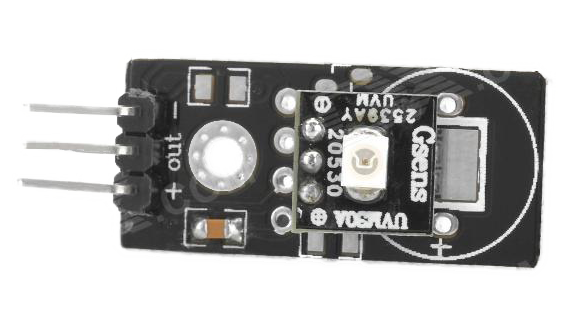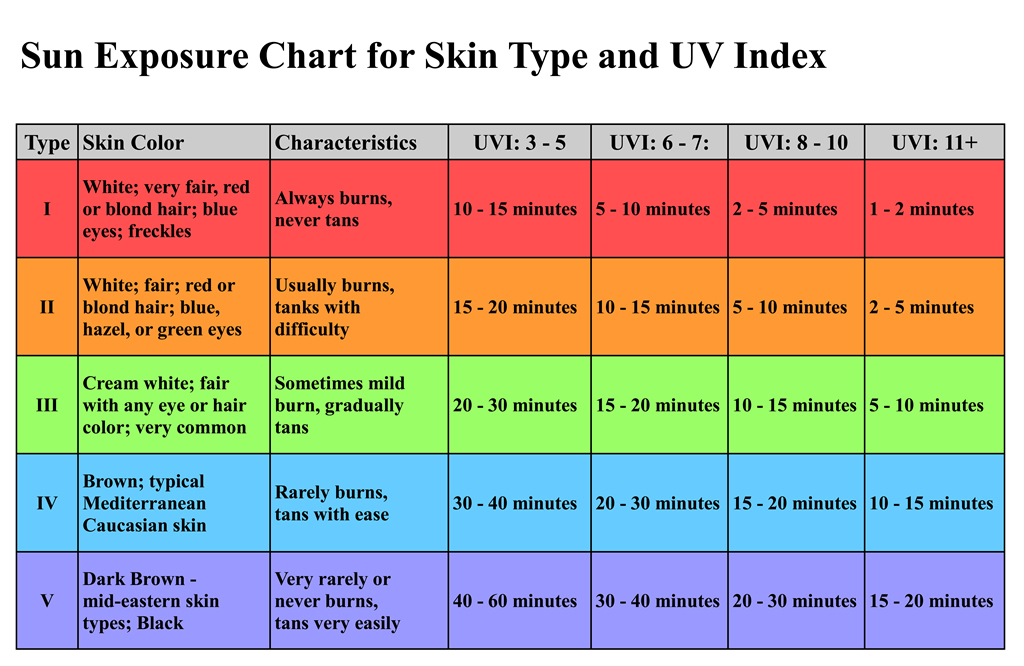
What do you do with a sensor detecting level of ultra violet light? Well...
You could build yourself a warning system to protect against sunburn and skin cancer! This sensor detects 280-390nm light most effectively. This is categorized as part of the UVB (burning rays) spectrum and most of the UVA (tanning rays) spectrum.
The provided example sketch calculates and send in UV index value to your controller.
 ## Wiring Things Up
## Wiring Things Up
Start by connecting the radio module.
| Sensor | Arduino | Comment |
|---|---|---|
| GND | GND | - |
| VCC | +5V | - |
| OUT | A0 | - |
Example
/*
* The MySensors Arduino library handles the wireless radio link and protocol
* between your home built sensors/actuators and HA controller of choice.
* The sensors forms a self healing radio network with optional repeaters. Each
* repeater and gateway builds a routing tables in EEPROM which keeps track of the
* network topology allowing messages to be routed to nodes.
*
* Created by Henrik Ekblad <[email protected]>
* Copyright (C) 2013-2019 Sensnology AB
* Full contributor list: https://github.com/mysensors/MySensors/graphs/contributors
*
* Documentation: http://www.mysensors.org
* Support Forum: http://forum.mysensors.org
*
* This program is free software; you can redistribute it and/or
* modify it under the terms of the GNU General Public License
* version 2 as published by the Free Software Foundation.
*
*******************************
*
* REVISION HISTORY
* Version 1.0 - epierre
* Contribution: bulldoglowell, gizmocuz
*
* DESCRIPTION
* Arduino UVM-30A
* Index table taken from: http://www.elecrow.com/sensors-c-111/environment-c-111_112/uv-sensor-moduleuvm30a-p-716.html
* Because this table is pretty lineair, we can calculate a UVI with one decimal
*
* Connect sensor:
*
* + >>> 5V
* - >>> GND
* out >>> A0
*
* License: Attribution-NonCommercial-ShareAlike 3.0 Unported (CC BY-NC-SA 3.0)
*/
// Enable debug prints to serial monitor
#define MY_DEBUG
// Enable and select radio type attached
#define MY_RADIO_RF24
//#define MY_RADIO_NRF5_ESB
//#define MY_RADIO_RFM69
//#define MY_RADIO_RFM95
#include <MySensors.h>
#define UV_SENSOR_ANALOG_PIN 0
#define CHILD_ID_UV 0
uint32_t SLEEP_TIME = 30*1000; // Sleep time between reads (in milliseconds)
MyMessage uvMsg(CHILD_ID_UV, V_UV);
uint32_t lastSend =0;
float uvIndex;
float lastUV = -1;
uint16_t uvIndexValue [12] = { 50, 227, 318, 408, 503, 606, 696, 795, 881, 976, 1079, 1170};
void presentation()
{
// Send the sketch version information to the gateway and Controller
sendSketchInfo("UV Sensor", "1.2");
// Register all sensors to gateway (they will be created as child devices)
present(CHILD_ID_UV, S_UV);
}
void loop()
{
uint32_t currentTime = millis();
uint16_t uv = analogRead(UV_SENSOR_ANALOG_PIN);// Get UV value
if (uv>1170) {
uv=1170;
}
//Serial.print("UV Analog reading: ");
//Serial.println(uv);
int i;
for (i = 0; i < 12; i++) {
if (uv <= uvIndexValue[i]) {
uvIndex = i;
break;
}
}
//calculate 1 decimal if possible
if (i>0) {
float vRange=uvIndexValue[i]-uvIndexValue[i-1];
float vCalc=uv-uvIndexValue[i-1];
uvIndex+=(1.0/vRange)*vCalc-1.0;
}
//Serial.print("UVI: ");
//Serial.println(uvIndex,2);
//Send value to gateway if changed, or at least every 5 minutes
if ((uvIndex != lastUV)||(currentTime-lastSend >= 5UL*60UL*1000UL)) {
lastSend=currentTime;
send(uvMsg.set(uvIndex,2));
lastUV = uvIndex;
}
sleep(SLEEP_TIME);
}